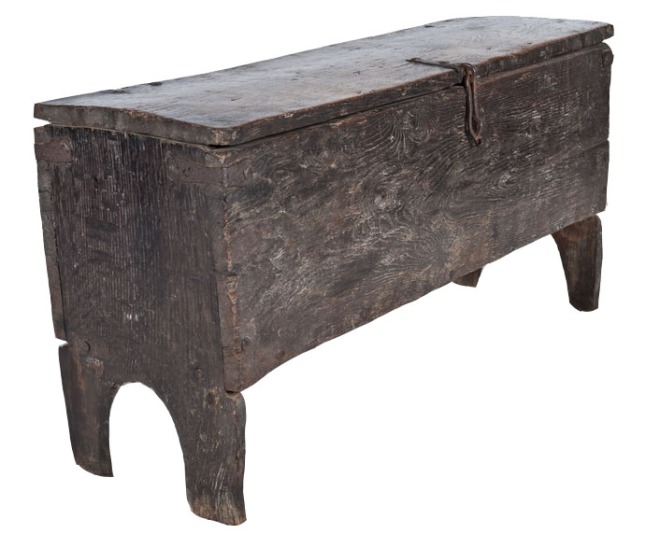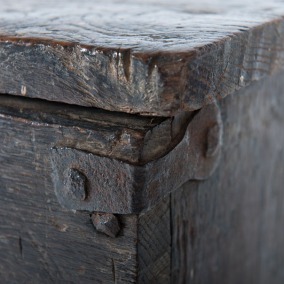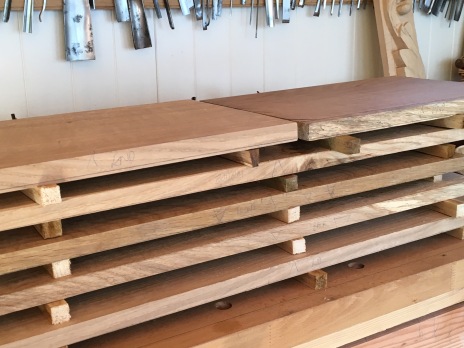One down. At least three to go. The list of projects for this demonstration gets longer every time I open a book. With the workbench finished I’ve turned my attention to some ‘flat work’. Staked stools and demonstration tools can wait. There are at least three chests I’d like to build for this: a Viking piece based on the Mastermyer chest, a clamp-front and this project.
I’m writing this half way through building it and have I realised that I’m going to have to do it twice. Once to have a complete chest to show and then again to demonstrate the process. Fortunately it’s about as easy as furniture construction gets: a ‘six board’, ‘six plank’, ‘slab-end’ or just ‘boarded’ or ‘plank’ chest. Six bits of wood and some fastenings.
I’ve taken the opportunity to try a variety of techniques. There are several surviving chests that use pegs and at least as many that are nailed from around the period we’re interested in. Copper rivets1 were also in use and since I’ve got plenty kicking around from boatbuilding projects I’m hoping to squeeze some in. Two chests may not be enough.

A starting point: riven oak late medieval plank chest. Courtesy of Marhamchurch Antiques.
This chest will come from a single rough-sawn board. It is definitely a small chest; height and depth are dictated by the available timber. The inspiration for this piece is from two different chests (above and below) that have been sold by Marhamchurch Antiques in Devon. They’re a bit later than the period we’re interested in but the only strong sign of this are the trefoil arches on the first chest that form the feet. Other than that either could have been built hundreds of years earlier.
 Six board chests are built with simple construction rather than longevity in mind. The grain on the sides is perpendicular to the grain on the ends. The movement of the timber will eventually cause the fastenings to loosen and the boards to split. Despite this many survive because there are ways around this:
Six board chests are built with simple construction rather than longevity in mind. The grain on the sides is perpendicular to the grain on the ends. The movement of the timber will eventually cause the fastenings to loosen and the boards to split. Despite this many survive because there are ways around this:
 Keep it small. The narrower the long planks the less movement there will be and so the fastenings are more likely to be able to resist the seasonal changes and the boards won’t split. I estimate that the front board from the riven oak chest from Marhamchurch Antiques is about 18′ high and even in riven stock that creates a lot of movement causing a split near the bottom.
Keep it small. The narrower the long planks the less movement there will be and so the fastenings are more likely to be able to resist the seasonal changes and the boards won’t split. I estimate that the front board from the riven oak chest from Marhamchurch Antiques is about 18′ high and even in riven stock that creates a lot of movement causing a split near the bottom.- Build it from cleft (riven) or rift-sawn stock. Movement across the grain in the tangential plain (at a tangent to the growth rings of the tree) is twice that in the radial plain (a straight line going from the middle of the tree to the bark). Radially cleft, or riven, timber was common in Anglo-Scandinavian England2. This means that the pieces will inevitably be narrower than flat-sawn panels and the movement will be significantly reduced. You can see this in the first chest to the right but not in the second which appears to be built of flat sawn boards. In the second chest the sides may have shrunk away from the notches at the bottom leaving a gap. In the first they have not.
 Use metal straps. Many surviving large six board chests have substantial metal reinforcements. However a lot of these are ecclesiastical pieces or come from the estates of powerful and wealthy individuals. They are not the focus of this demonstration. The second chest from Marhamchurch compensates for its flat sawn grain by reinforcing the joints at the top. It’s hard to know whether this was done at the time of manufacture or later as the joints worked loose with the seasons. The position of the strap over the nail and the difference between the two nails suggests the latter.
Use metal straps. Many surviving large six board chests have substantial metal reinforcements. However a lot of these are ecclesiastical pieces or come from the estates of powerful and wealthy individuals. They are not the focus of this demonstration. The second chest from Marhamchurch compensates for its flat sawn grain by reinforcing the joints at the top. It’s hard to know whether this was done at the time of manufacture or later as the joints worked loose with the seasons. The position of the strap over the nail and the difference between the two nails suggests the latter.
The design of this chest is dictated by the timber. Though the Egyptians had glue thousands of years before this time period I can find no evidence that the Anglo-Saxond or Anglo-Scandinavians did. Even if they did it was animal glue and would have faired poorly in the damp. That means that wide panels made up from a number of boards were not used. The front of a chest was as long and as high as the planks as the widest board you could get from a tree.
 Time spent picking through boards at the timber yard is well rewarded. (And so is being nice to the man with the huge forklift. I learnt a lot from him that day.) I wanted to select wide stock with vertical grain. Access to large-diameter fresh cut oak is rare so riven stock is out of the question and that left me searching for the widest boards sawn from the middle of the log.
Time spent picking through boards at the timber yard is well rewarded. (And so is being nice to the man with the huge forklift. I learnt a lot from him that day.) I wanted to select wide stock with vertical grain. Access to large-diameter fresh cut oak is rare so riven stock is out of the question and that left me searching for the widest boards sawn from the middle of the log.
With a newly commissioned low bench sitting in the garden I started by trying to work the boards to their final dimensions in a manner that might be familiar to a medieval joiner. Sawing went well. It’s little more than a giant saw bench and I’m comfortable using it as such. Heavy planing was more of an issue. Bent forward, pushing a plane with just my arms was hard and uncomfortable work. When standing at the traditional joiner’s bench many more of my muscles help out. The much bigger and more resilient muscles of my legs do a lot of the work.
Frustrated and realising that I would wake up the next day aching and with much less work done than I had planned I went back to my familiar friend – the joiner’s bench. There is plenty of time to play with the low bench between now and the demonstration.
 I planed each piece to just over 3/4′ leaving a little spare to remove once the boards had moved a little more. A couple of weeks in stick and they were ready for joinery.
I planed each piece to just over 3/4′ leaving a little spare to remove once the boards had moved a little more. A couple of weeks in stick and they were ready for joinery.
This gave me a bit of time to decide on fastenings. Chris Schwarz3 asserts that nails are the the secret to surviving chests’ longevity. They “allow you to get away with serious crimes of wood movement… a nail will allow the wood to expand and contract, bending back and forth through the yearly humidity cycles.” This also means that they will loosen over time. But it’s the best of a bad job.

Not a medieval dowel plate. Its laser cut descendant.
Nails were made by blacksmiths, each one hand forged. So if a joiner wants to join a chest with nails s/he must buy (or trade for) them. But a dowel plate is a one-off purchase and then you’ve got pegs for life.
There aren’t enough extant medieval plank chests to be able to draw a conclusion about what was used more – pegs or nails – but in the interest of self-reliance I’ve used the trunnels for this chest.
Next time: joinery.
1. “Radially split offcuts of other species include… an alder fragment with 30-40 copper alloy rivets embedded in it…” Morris, C., Wood and Woodworking in Anglo-Scandinavian and Medieval York p. 2221-2223
2. “Most conversion of wood for artefacts was done by radial splitting…” Morris, C., Wood and Woodworking in Anglo-Scandinavian and Medieval York p. 2104
3.

This is such an interesting topic. But I am not quafliied to comment , so I just would have liked a like button. Please post more. A subscriber
LikeLike
Thanks Paul!
LikeLike
Looking forward to the next installment.
LikeLike
The next one has real woodwork in it. Finished the body of the chest; need to make some snipe hinges for the lid.
LikeLike